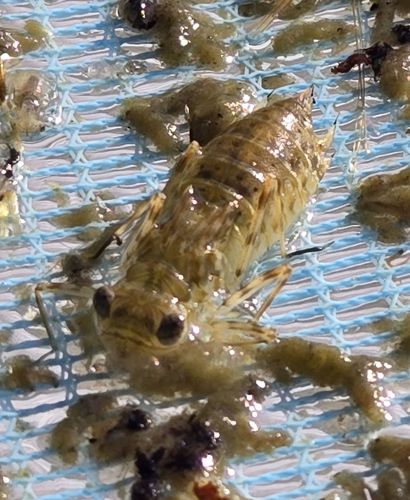Dragonfly Nymph (or Larva)
Scientific Name: Various species within the order Odonata, suborder Anisoptera
Order & Family: Order Odonata (Dragonflies and Damselflies), Family (e.g., Aeshnidae, Libellulidae, Gomphidae are common families). Based on the robust body and large eyes, this is likely an Aeshnidae (Darner dragonfly) or Libellulidae (Skimmer dragonfly) nymph.
Size: Typically 2-6 cm (0.8-2.4 inches) depending on the species and developmental stage.

Natural Habitat
Aquatic, found in various freshwater environments such as ponds, lakes, slow-moving rivers, and marshes. They typically cling to submerged vegetation, rocks, or burrow in sediment.
Diet & Feeding
Opportunistic predators. They feed on a wide range of aquatic invertebrates, including mosquito larvae, tadpoles, small fish, and other insect larvae. They capture prey by extending a hinged lower lip (labium) with hooks.
Behavior Patterns
Nymphs are primarily aquatic and spend months to several years in this stage. They are ambush predators, often camouflaged to blend with their surroundings. They breathe through gills located inside their rectum, drawing water in and expelling it, which can also be used for jet propulsion to escape predators. They undergo multiple molts before emerging from the water as adult dragonflies.
Risks & Benefits
Benefits: Dragonfly nymphs are crucial components of freshwater ecosystems. They are significant predators of mosquito larvae, helping to control mosquito populations, which can reduce the incidence of mosquito-borne diseases. They also serve as a food source for fish and birds. Risks: Generally, no direct risks to humans. They do not bite or sting humans. However, due to their predatory nature, they can impact populations of smaller aquatic organisms, which is a natural part of the food web.
Identified on: 9/11/2025